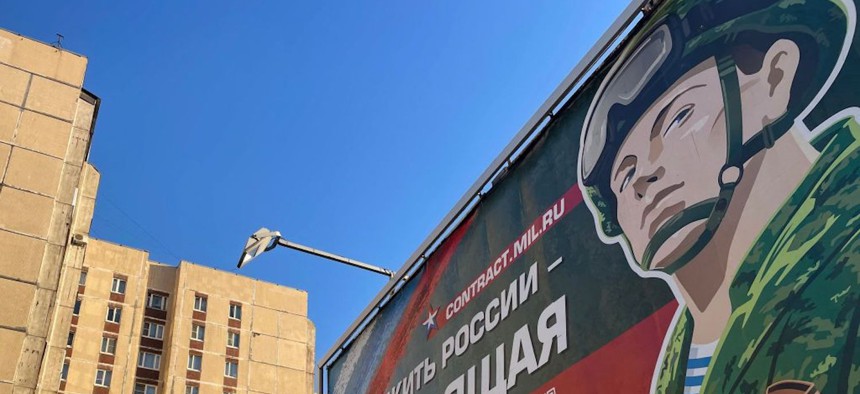
billboard promoting contract army service and reading "Serving Russia is the real job" sits in Saint Petersburg on April 23, 2023. (Photo by Kirill KUDRYAVTSEV / AFP Photo by KIRILL KUDRYAVTSEV/AFP via Getty Images
Without A New Draft, Russian Offensive Operations Are Over, US Intel Chiefs Say
It could take a decade before Russian ground forces are back to where they were before the war.
Russian efforts to seize more Ukrainian territory are likely doomed unless the Kremlin manages to launch another draft, U.S. intelligence chiefs told lawmakers on Thursday, adding that Russia’s ground forces will in any case need years to rebuild.
“If Russia does not initiate a mandatory mobilization and secure substantial third-party ammunition supplies beyond existing deliveries, from Iran and others, it will be increasingly challenging for them to sustain even modest offensive operations,” Avril Haines, who heads the Office of the Director of National Intelligence or ODNI, told the Senate Armed Services Committee.
Gen. Scott Berrier, who heads the Defense Intelligence Agency, or DIA, confirmed the analysis. “The reorganization that the Russian military took in the early 2000s meant that they were better, faster, smaller…from what they were in the Soviet era. That army largely is gone and they're relying on reserves and reserve equipment, older Soviet-era kinds of kit. It's gonna take them a while to build back to more advanced kit. The estimates go from five to 10 years based on how sanctions affect them.”
Many observers of the Russian military in Europe and in Washington have argued that a second mobilization would be nearly impossible for Russia to undertake successfully and would put Russian President Vladimir Putin in a politically perilous position.
Haines and Berrier’s remarks follow April statements from Gen. Chris Cavoli, who heads U.S. European Command. Cavoli told lawmakers that Russian ground forces had been degraded “somewhat” but that Russian nuclear forces, including bombers and submarines, remained untouched by the war.
Some pro-Russian voices on Twitter framed Cavoli’s comments as an indication that war has not affected Russian forces and that Russia retained the advantage in the conflict.
Berrier said his analysis of the situation was “very, very similar” to Cavoli’s in thatRussia remained an “existential threat with a nuclear arsenal that they have.”
Haines said Putin likely still aims to destroy Ukraine as a free, independent nation but that the Russian leader recognizes he won’t be able to achieve that objective anytime soon. “We assess that Putin probably has scaled back his immediate ambitions to consolidate control of the occupied territory in eastern and southern Ukraine, and ensuring that Ukraine will never become a NATO ally,” she said. He “may be willing to claim at least a temporary victory based on roughly the territory he is occupying.”
But while Putin may have hit a wall in Ukraine, Russian forces are branching out elsewhere. Last week, Cavoli testified that Russian submarine activity had been increasing in some parts of the Atlantic. Lt. Gen. Alexus Grynkewich, who leads Air Forces Central Command, recently told Defense One that Russian pilots over Syria are trying to goad U.S. pilots into dogfights.
Sen. Tom Cotton, R-Ark., asked Berrier and Haines about such actions. “Are there other instances of growing Russian aggression and…what's the intelligence community's assessment for why Russia has grown increasingly aggressive in these ways?”
Haines asked to respond in closed session.


